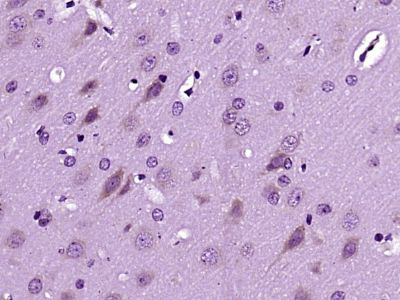产品货号 : mlR11456
英文名称 : Dscam
中文名称 : 唐氏综合征细胞粘附分子抗体
别 名 : CHD2 42; CHD2 52; CHD2; Down syndrome cell adhesion molecule; DSCAM; DSCAM_HUMAN; human CHD2-52 down syndrome cell adhesion molecule 2, 9; OTTHUMP00000109193 2; SD11109p.
研究领域 : 细胞生物 发育生物学 神经生物学
抗体来源 : Rabbit
克隆类型 : Polyclonal
交叉反应 : Human, Mouse, Rat, Chicken, Dog, Cow, Horse, Sheep,
产品应用 : ELISA=1:500-1000 IHC-P=1:400-800 IHC-F=1:400-800 ICC=1:100-500 IF=1:100-500 (石蜡切片需做抗原修复)
not yet tested in other applications.
optimal dilutions/concentrations should be determined by the end user.
分 子 量 : 220kDa
细胞定位 : 细胞膜 分泌型蛋白
性 状 : Lyophilized or Liquid
浓 度 : 1mg/ml
免 疫 原 : KLH conjugated synthetic peptide derived from human Dscam:301-400/2012 <Extracellular>
亚 型 : IgG
纯化方法 : affinity purified by Protein A
储 存 液 : 0.01M TBS(pH7.4) with 1% BSA, 0.03% Proclin300 and 50% Glycerol.
保存条件 : Store at -20 °C for one year. Avoid repeated freeze/thaw cycles. The lyophilized antibody is stable at room temperature for at least one month and for greater than a year when kept at -20°C. When reconstituted in sterile pH 7.4 0.01M PBS or diluent of antibody the antibody is stable for at least two weeks at 2-4 °C.
PubMed : PubMed
产品介绍 : DSCAM is a cell adhesion molecule belonging to the immunoglobulin superfamily. It is predominantly expressed in brain and contains six Fibronectin type-III domains and ten Ig-like C2-type domains. In mice, DSCAM is responsible for regulating isoneuronal self-avoidance, the tendency for sister arbors to avoid crossing each other and to spread out proportionately over an area. Isoneuronal self-avoidance is important for proper terminal branching (arborization). In some cell types, DSCAM also mediates heteroneuronal self-avoidance, which is important for the regular spacing of cell bodies and the prevention of hyperfasciculation. In humans, two DSCAM isoforms exist due to alternative splicing. The long isoform (also known as CHD2-42) is a single pass type I membrane protein, while the short isoform (CHD2-52), which lacks the C-terminal transmembrane containing region (amino acids 1572-2012), is secreted.
Function:
Cell adhesion molecule that plays a role in neuronal self-avoidance. Promotes repulsion between specific neuronal processes of either the same cell or the same subtype of cells. Mediates within retinal amacrine and ganglion cell subtypes both isoneuronal self-avoidance for creating an orderly dendritic arborization and heteroneuronal self-avoidance to maintain the mosaic spacing between amacrine and ganglion cell bodies. Receptor for netrin required for axon guidance independently of and in collaboration with the receptor DCC. In spinal chord development plays a role in guiding commissural axons projection and pathfinding across the ventral midline to reach the floor plate upon ligand binding. Enhances netrin-induced phosphorylation of PAK1 and FYN. Mediates intracellular signaling by stimulating the activation of MAPK8 and MAP kinase p38.
Subunit:
Interacts with DCC; the interaction is abolished in response to NTN1 (By similarity). Probably found in a ternary complex composed of DSCAM, PAK1 and RAC1. Interacts (via extracellular domain) with NTN1. Interacts (via cytoplasmic domain) with PAK1; the interaction is direct and enhanced in presence of RAC1. Interacts with RAC1; the interaction requires PAK1.
Subcellular Location:
Secreted and Cell membrane. Localized in the soma, cell membrane, axon and growth cone of dissociated commissural axons.
Tissue Specificity:
Primarily expressed in brain.
Post-translational modifications:
Phosphorylated at tyrosine residues. Phosphorylation is enhanced by netrin.
Similarity:
Contains 6 fibronectin type-III domains.
Contains 10 Ig-like C2-type (immunoglobulin-like) domains.
SWISS:
O60469
Gene ID:
1826
Important Note:
This product as supplied is intended for research use only, not for use in human, therapeutic or diagnostic applications.
产品图片












